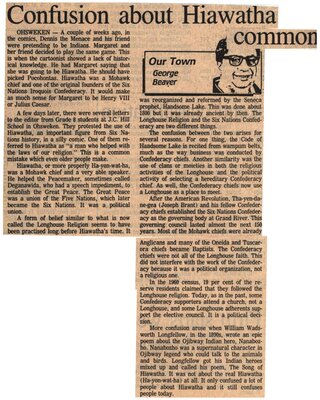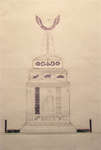"Confusion About Hiawatha Common"
- Full Text
- Confusion about Hiawatha common
OHSWEKEN - A couple of weeks ago, in the comics, Dennis the Meance and his friend were pretending to be Indians. Margaret and her friend decided to play the same game. This is when the cartoonist showed a lack of historical knowledge. He had Margaret saying that she was going to be Hiawatha. He should have picked Pocohontas. Hiawatha was a Mohawk chief and one of the original founders of the Six Nations Iroquois Confederacy. It would make as much sense for Margaret to be Henry VIII or Julius Caesar.
A few days later, there were several letters to the editor from Grade 8 students at J.C. Hill School in Ohsweken. They protested the use of Hiawatha, an important figure from Six Nations history, in a silly comic. One of them referred to Hiawatha as "a man who helped with the laws of our religion." This is a common mistake which even older people make.
Hiawatha, or more properly Ha-yon-wat-ha, was a Mohawk chief and a very able speaker. He helped the Peacemaker, sometimes called Deganawida, who had a speech impediment, to establish the Great Peace. The Great Peace was a union of the Five Nations, which later became the Six Nations. It was a political union.
A form of belief similar to what is now called the Longhouse Religion seems to have been practised long before Hiawatha's time. It was reorganized and reformed by the Seneca prophet, Handsome Lake. This was done about 1800 but it was already ancient by then. The Longhouse Religion and the Six Nations Confederacy are two different things.
The confusion between the two arises for several reasons. For one thing, the Code of Handsome Lake is recited from wampum belts, much as the way business was conducted by Confederacy chiefs. Another similarity was the use of clans or moieties in both the religious activities of the Longhouse and the political activity of selecting a hereditary Confederacy chief. As well, the Confederacy chiefs now use a Longhouse as a place to meet.
After the American Revolution, Tha-Yen-da-ne-gea (Joseph Brant) and his fellow Confederacy chiefs established the Six Nations Confederacy as the governing body at Grand River. This governing council lasted almost the next 150 years. Most of the Mohawk chiefs were already Anglicans and many of the Oneida and Tuscarora chiefs became Baptists. The Confederacy chiefs were not all of the Longhouse faith. This did not interfere with the work of the Confederacy because it was a political organization, not a religious one.
In the 1960 census, 19 per cent of the reserve residents claimed that they followed the Longhouse religion. Today, as in the past, some Confederacy supporters attend a church, not a Longhouse, and some Longhouse adherents support the elective council. It is a political decision.
More confusion arose when William Wadsworth Longfellow, in the 1800s, wrote an epic poem about the Ojibway Indian hero, Nanabozho. Nanabozho was a supernatural character in Ojibway legend who could talk to the animals and birds. Longfellow got his Indian heroes mixed up and called his poem, The Song of Hiawatha. It was not about the real Hiawatha (Ha-yon-wat-ha) at all. It only confused a lot of people about Hiawatha and it still confuses people today.
- Mystery Question
- When was this article published?[Please answer by clicking on the Comments tab]
- Creator
- Beaver, George, Author
- Media Type
- Newspaper
- Item Types
- Articles
- Clippings
- Description
- "A couple of weeks ago, in the comics, Dennis the Menace and his friend were pretending to be Indians. Margaret and her friend decided to play the same game. This is when the cartoonist showed a lack of historical knowledge. He had Margaret saying that she was going to be Hiawatha. He should have picked Pohohontas. Hiawatha was a Mohawk chief and one of the original founders of the Six Nations Iroquois Confederacy. It would make as much sense for Margaret to be Henry VIII or Julius Caesar."
- Subject(s)
- Personal Name(s)
- Brant, Joseph ; Longfellow, William Wadsworth.
- Local identifier
- SNPL002567v00d
- Collection
- Scrapbook #1 by Janet Heaslip
- Language of Item
- English
- Geographic Coverage
-
-
Ontario, Canada
Latitude: 43.06681 Longitude: -80.11635
-
- Creative Commons licence
 [more details]
[more details]- Copyright Statement
- Public domain: Copyright has expired according to Canadian law. No restrictions on use.
- Copyright Holder
- Brantford Expositor
- Contact
- Six Nations Public LibraryEmail:info@snpl.ca
Website:
Agency street/mail address:1679 Chiefswood Rd
PO Box 149
Ohsweken, ON N0A 1M0
519-445-2954



